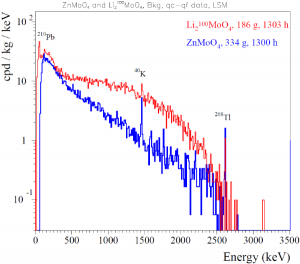Results and status of the experiment: January 2017.
categories: Results
Tests of the LUMINEU detectors are ongoing since 2013 in the cryogenic laboratory of CSNSM (Orsay, France), at LSM (France) and LNGS (Italy). This activity has allowed us to reach remarkable results that show the maturity of the LUMINEU technology.
- We have developed a purification-crystallization protocol for the production of high quality crystals implying low irrecoverable losses (< 4%) of the costly enriched molybdenum. Crystal growth is performed at NIIC (Novosibirsk, Russia).
- We have fabricated and operated several detectors from natural and enriched materials optimizing the radiopurity, the energy resolution and the α/β rejection capability.
- We have ascertained that the crystal growth is much easier for Li2MoO4 than for ZnMoO4, providing boules with more regular shapes and less macroscopic defects and inclusions.
- Several 44 mm diameter, 170 micron thick Ge light detectors were fabricated according to a robust mounting scheme developed at CSNSM and successfully tested on different ZMO detectors. Study of the immunity to noise vibrations and the absolute light responsivity of existing light detectors (diameters 25 mm & 40 mm) developed at IAS has been performed at CSNSM in dilution refrigerators based on a pulse-tube dry technology. IAS light detectors have exhibited excellent performance (50 eV baseline width) and future design of light detectors will try to incorporate some features of the IAS scheme. A full study of the luminescence under X-rays of ZMO sample crystals was performed at IAS and KINR in the 1.4K-300K range for light detector response optimization.
- We have performed a dedicated R&D to control the internal 40K content in Li2MoO4. The present recipe, which includes the use of a selected ultapure Li2CO3 powder for the compound synthesis and a double crystallization procedure, allowed us to achieve a harmless 40K activity, inferior to 6 mBq/kg.
- KIP Heidelberg and CEA have designed a prototype of a light detector with MMC readout, aiming at outstanding energy resolution, threshold and speed. The first prototype wafers are presently processed at Heidelberg.
- Ten Ge wafers were irradiated at the Orphée reactor for the NTD sensor production specific for LUMINEU. Several NbSi film superconductive thermistors have been prepared and characterized as alternative temperature sensors.
- A Monte Carlo simulation of the background expected for the ZMO detectors in the EDELWEISS cryostat is in progress, with the objective to evaluate the sensitivity of the pilot LUMINEU experiment (4 enriched crystals, 0.7 kg enriched material) and of a possible post-LUMINEU experiment with 45 crystals and 10 kg enriched material.
- The production of temperature sensors for LUMINEU will continue in the next months. First NTDs usable in detector prototypes are ready and are in process of characterization. As for the sensors based on NbSi films, after solving problems of adherence of the films and of the resins to the Ge substrate, the first operational thermometers are expected in a few months.
- In 2015-2016 we performed a test of two large-volume modules (ZnMoO4 and Li2100MoO4 crystal) in LSM, France. Enriched molybdenum was provided by the LUMINEU collaborators of ITEP (Moscow, Russia) and KINR (Kyiv, Ukraine). The goal was to compare this two types of detectors to choose one with better properties and performance and to check new suspension system for reduction of low frequency noise. Though ZnMoO4 is a very promising material as well, Li2MoO4 devices have superior performance and radiopurity, and a less pronounced boule-position dependence. All these characteristics allowed us to choose Li2100MoO4 compound as main part of detectors for final stage of LUMINEU experiment with 40 crystals. The background spectra of these two crystals is shown on fig. 1.
Figure 1
- Also independent measurement of the Li2100MoO4 was performed in LNGS, Italy, to compare radiopurity of two crystals from the same boule and reproducibility of performance. The excellent performance of the enriched Li2100MoO4 detectors can be appreciated in Fig. 2. From the background measurement, it is possible to extract preliminarily the half-life of the ordinary two-neutrino double-beta decay, with a very simple background model which includes only the internal 40K contamination and describes the continuum of the residual background with an exponential function decreasing with energy.
Figure 2
- In 2016 new run with two suspended towers in LSM had started. The aim is to test performance and operation of four enriched Li2100MoO4 crystals before preparing and performing a demonstrator for CUPID with 20 crystals. Also towers contain two R&D detectors: CdWO4 and TeO2 with Neganov-Luke light detector.
- Crystal growth for demonstrator with 20 crystals had already started.


